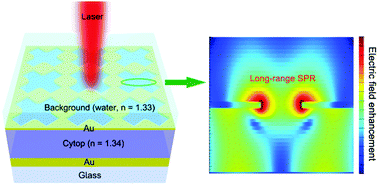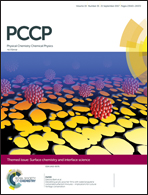Long-range surface plasmon resonance and surface-enhanced Raman scattering on X-shaped gold plasmonic nanohole arrays†
Abstract
A multilayered architecture including a thin Au film supporting an X-shaped nanohole array and a thick continuous Au film separated by a Cytop dielectric layer is reported in this work. Long-range surface plasmon resonance (LR-SPR) was generated at the top Au/water interface, which also resulted in a long-range surface-enhanced Raman scattering (LR-SERS) effect. LR-SPR originates from the coupling of surface plasmons (SPs) propagating along the opposite sides of the thin Au film embedded in a symmetric refractive index environment with Cytop (n = 1.34) and water (n = 1.33). The finite-difference time-domain (FDTD) simulation method was used to investigate the optimal dimensions of the substrate by studying the reflectance spectra and electric field profiles. The calculated optimal structure was then fabricated via electron beam lithography, and its LR-SERS performance was demonstrated by detecting rhodamine 6G and 4-mercaptobenzoic acid in the refractive index-matched environment. We believe that this structure as a LR-SPR or LR-SERS substrate can have broad applications in biosensing.



 Please wait while we load your content...
Please wait while we load your content...